-
Notifications
You must be signed in to change notification settings - Fork 802
features
This document describes the features supported by this extension.
- IntelliSense
- Code Navigation
- Syntax Highlighting
- Inlay Hints
- Code Editing
- Code Generation
- Diagnostics
- Code Lenses
- Run and test in the editor
- Debug your code
- Other
Completion results appear for symbols as you type. You can trigger this manually with the Ctrl+Space shortcut.
Autocompletion is also supported for packages you have not yet imported into your program.
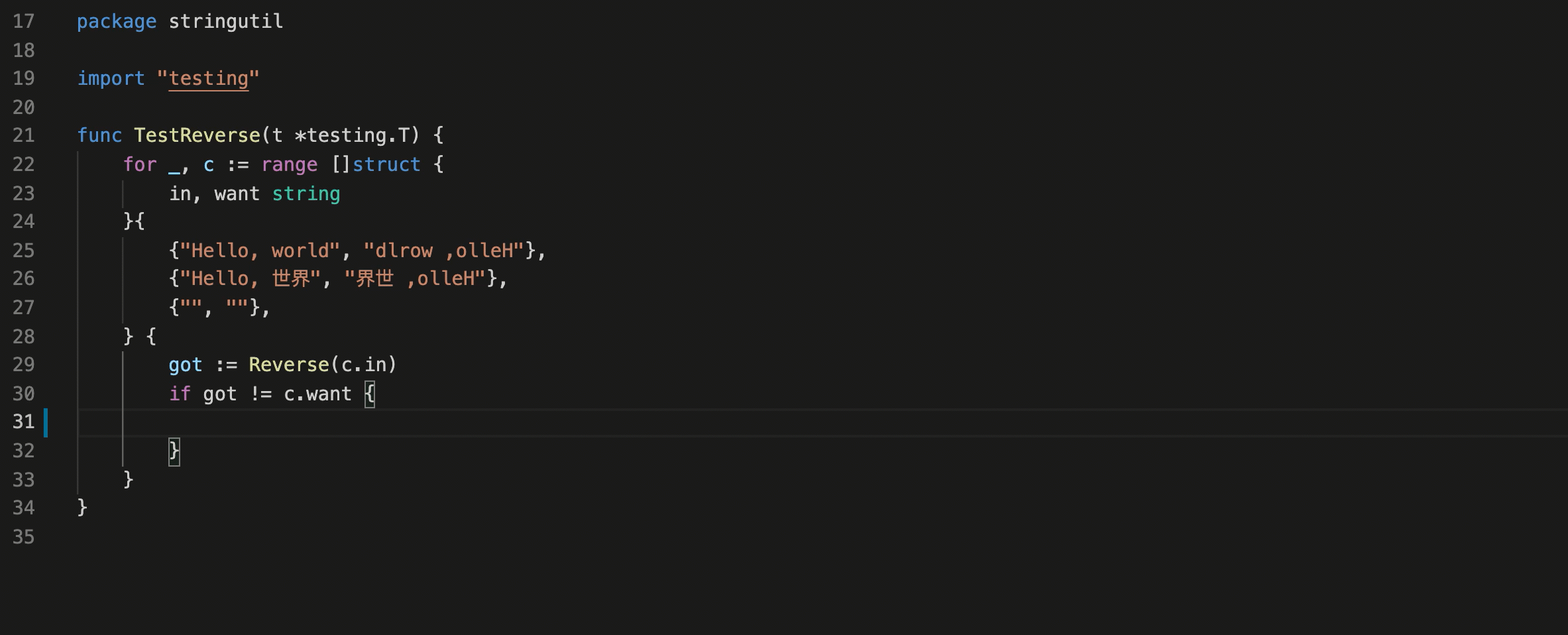
Information about the signature of a function pops up as you type in its parameters.
Documentation appears when you hover over a symbol.
Jump to or peek a symbol's declaration.
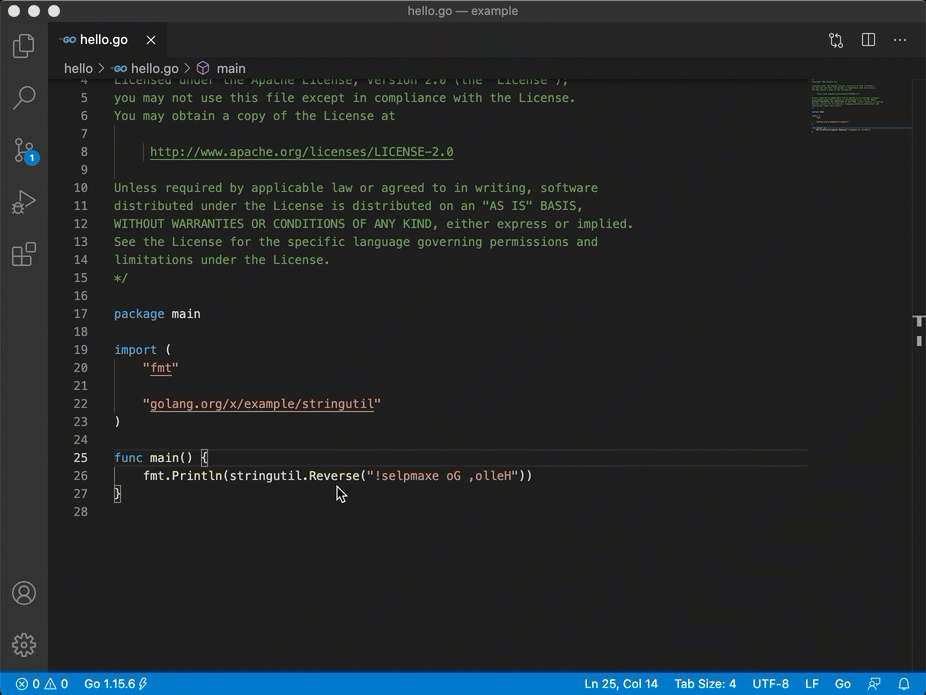
Find or go to the references of a symbol.
This feature is not available if you are using Go modules without gopls, the Go language server.
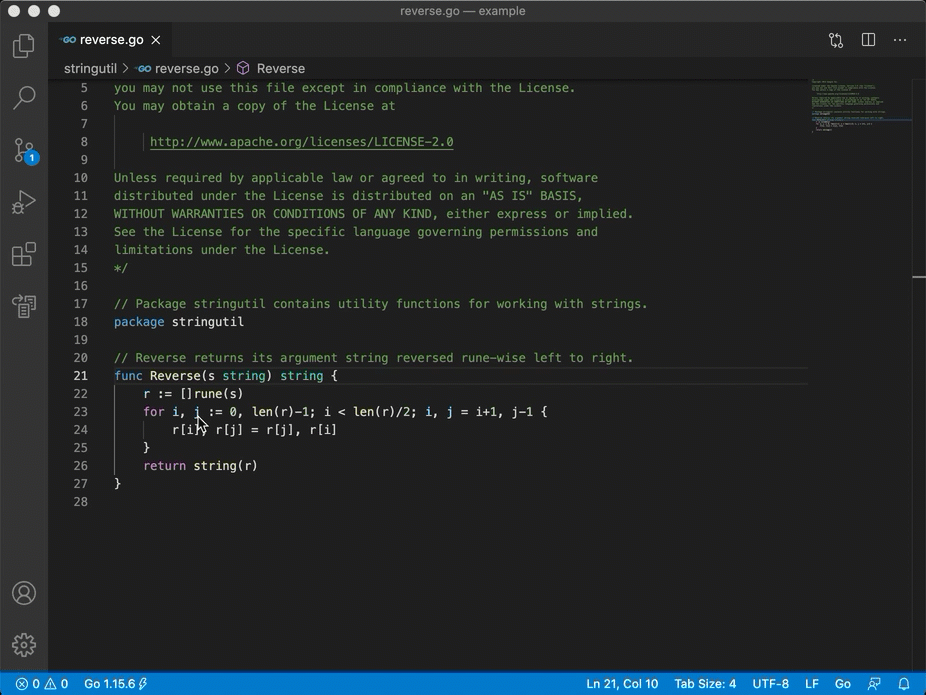
Find the concrete types that implement a given interface.
This feature is not available if you are using Go modules without gopls, the Go language server.
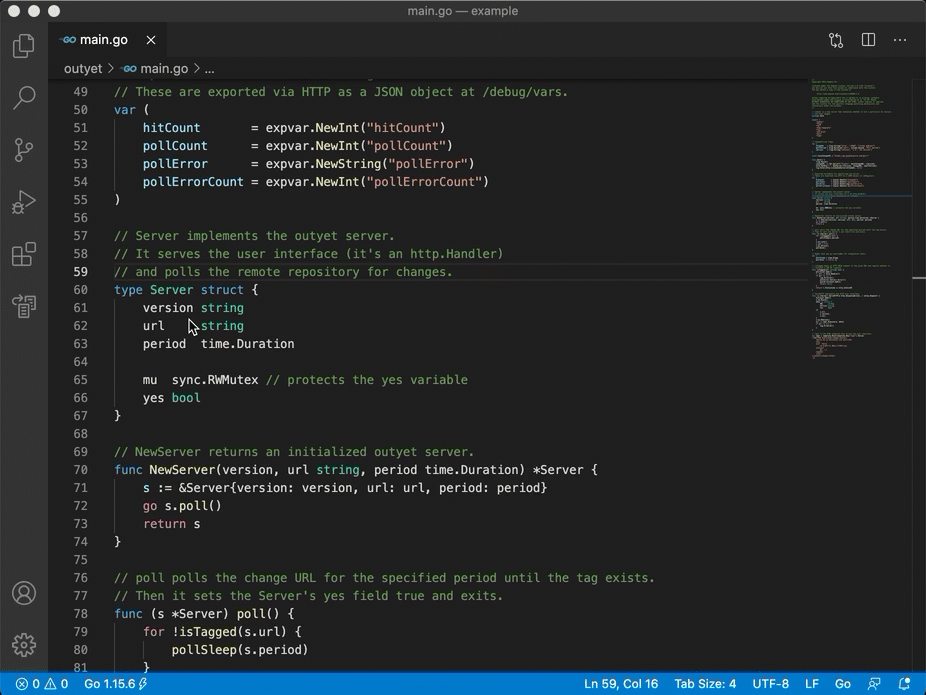
Search for symbols in your file or workspace by opening the Command Palette (Ctrl+Shift+P) and typing @ for symbols in the current file or # for symbols in the entire workspace.
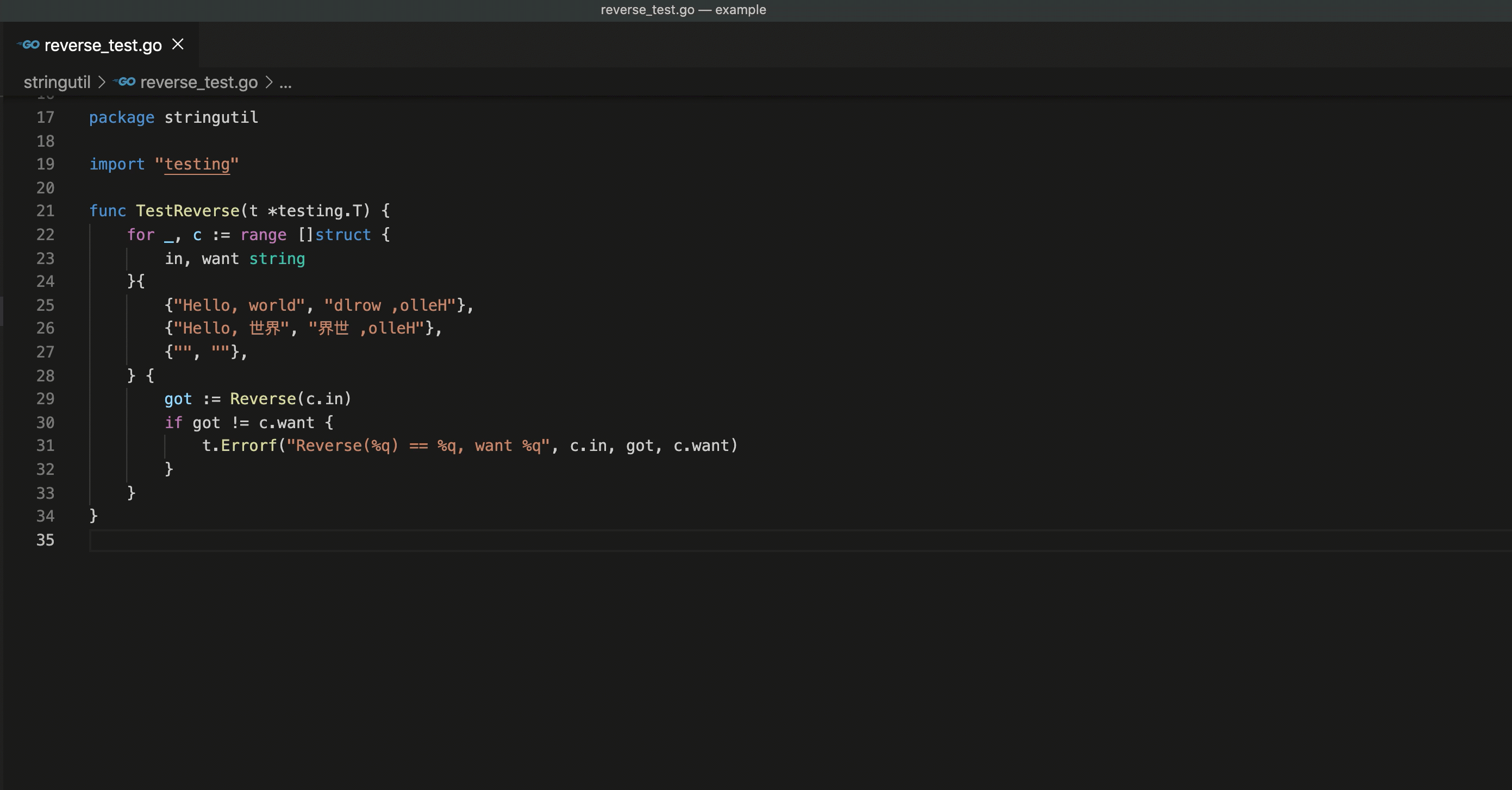
Show all calls from or to a function.
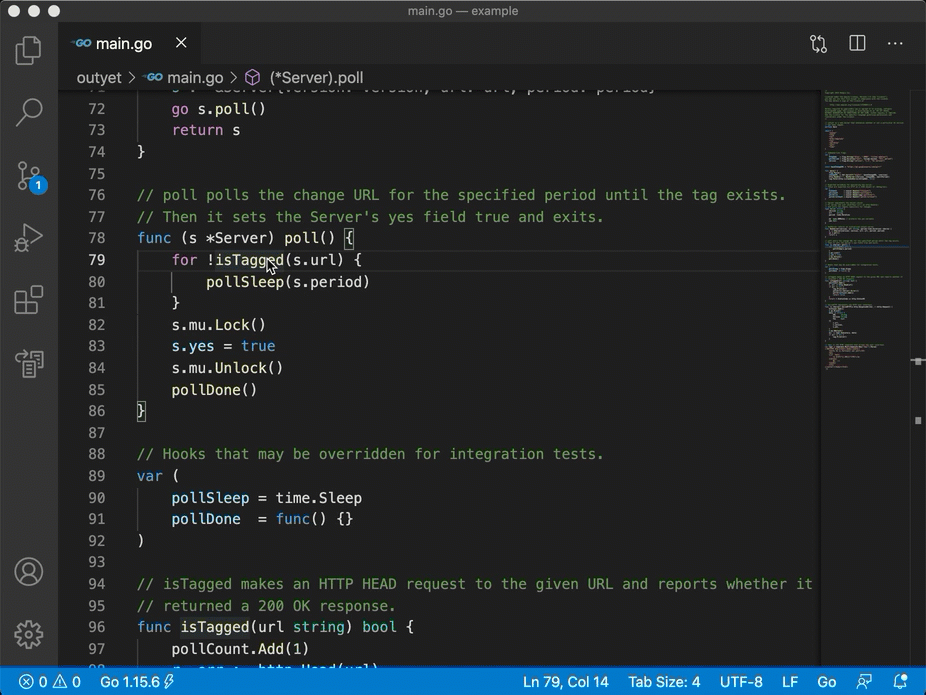
See all the symbols in the current file in the VS Code's Outline view.

Quickly toggle between a file and its corresponding test file by using the Go: Toggle Test File command.
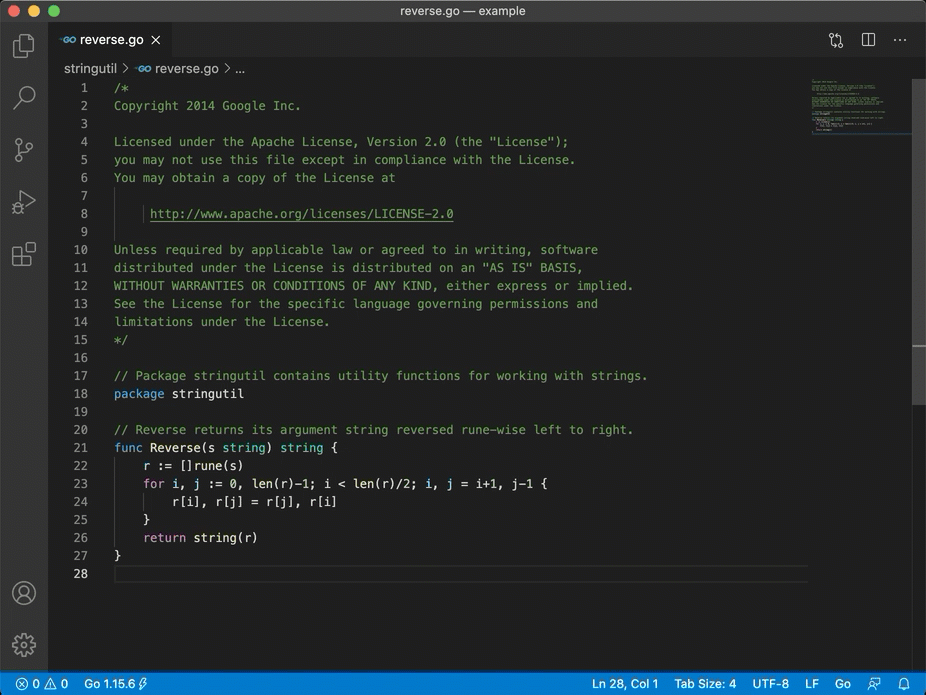
The default syntax highlighting for Go files is implemented in Visual Studio Code using TextMate grammar, not by this extension.
If you are using gopls, you can enable Semantic Highlighting for more accurate syntax highlighting based on semantic tokenization using this setting:
"gopls": {
"ui.semanticTokens": true,
// you can optionally turn on these features for more colors
// see https://go.dev/issue/45753 and https://go.dev/issue/45792
"ui.noSemanticString": true, // delegates string syntax highlighting to vscode
"ui.noSemanticNumber": true, // delegates number syntax highlighting to vscode
}
When gopls's semantic tokens feature is enabled, gopls also provides semantic tokens for Go template files (language identifier: gotmpl). By default, the extension associates all *.tmpl or *.gotmpl files in the workspace with gotmpl language. Users can override the language mode by using Visual Studio Code's UI or the "files.associations" setting. See Visual Studio Code's doc for more details.
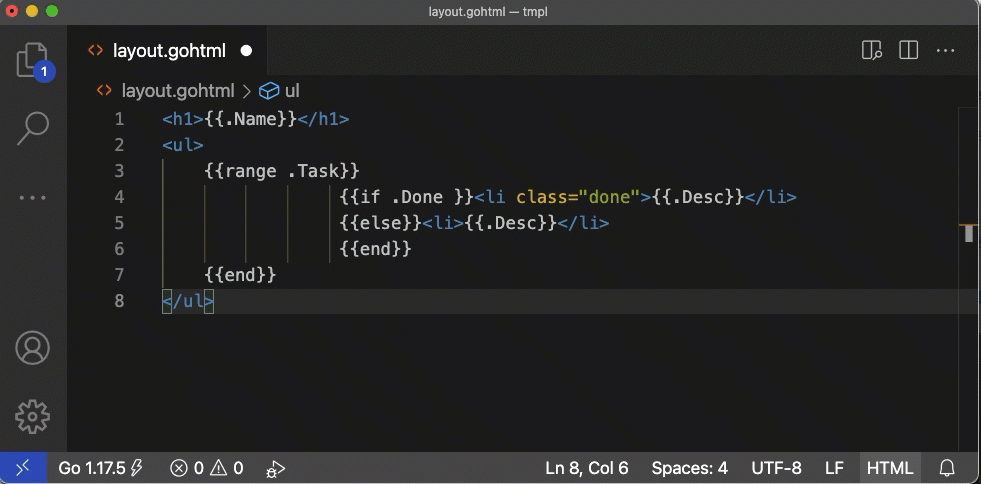
Inlay hints render additional inline information to source code to help you understand what the code does.
They can be enabled/disabled with the editor.inlayHints.enabled setting in combination with go.inlayHints settings to enable inlay hints types.
i/* int*/, j/* int*/ := 0, len(r)-1 for k/* int*/, v/* string*/ := range []string{} {
fmt.Println(k, v)
} {/*in: */"Hello, world", /*want: */"dlrow ,olleH"} for _, c := range []struct {
in, want string
}{
/*struct{ in string; want string }*/{"Hello, world", "dlrow ,olleH"},
} const (
KindNone Kind = iota/* = 0*/
KindPrint/* = 1*/
KindPrintf/* = 2*/
KindErrorf/* = 3*/
) myFoo/*[int, string]*/(1, "hello") parseInt(/* str: */ "123", /* radix: */ 8)Predefined snippets for quick coding. These snippets will appear as completion suggestions when you type. Users can also define their own custom snippets (see Snippets in Visual Studio Code).
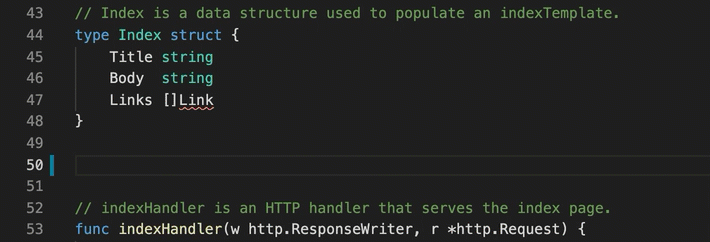
Format code and organize imports, either manually or on save.
The extension formats Go code, organizes imports, and removes unused imports by default. For different behavior, please override per-language default settings following the instruction.
When organizing imports, the imported packages are grouped in the default goimports style. In order to group some packages after 3rd-party packages, use the "formatting.local" setting.
"gopls": {
"formatting.local": "example.com/myorg,github.com/myorg2"
}The extension organizes imports automatically and can add missing imports if the package is present in your module cache already. However, you can also manually add a new import to your file through the Go: Add Import command. Available packages are offered from module cache (or from your GOPATH in GOPATH mode).
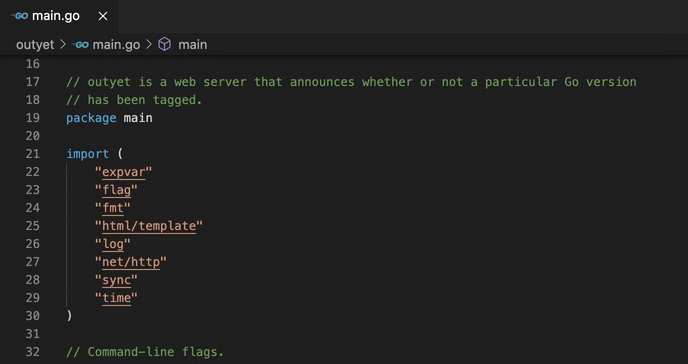
In addition to the default go fmt style formatter, the language server (gopls) supports github.com/mvdan/gofumpt style formatting. Use gopls's formatting.gofumpt setting:
"gopls": { "formatting.gofumpt": true }You can also configure to use other custom formatter (golines) by using the "go.formatTool" setting. The custom formatter must operate on file contents from STDIN, and output the formatted result to STDOUT.
"go.formatTools": "custom",
"go.alternateTools": {
// the binary name if it is in your PATH, or
// provide the exact path to your
// custom formatter.
"customFormatter": "golines"
}Rename all occurrences of a symbol in your workspace.
Note: For undo after rename to work on Windows, you need to have diff tool on your PATH.
This feature is not available if you are using Go modules without gopls, the Go language server.
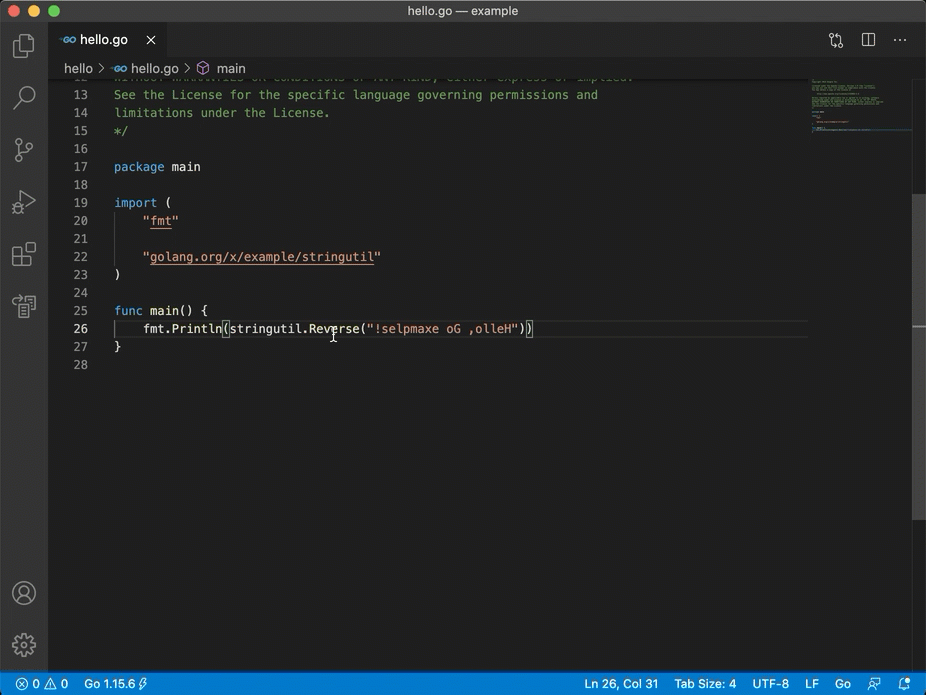
Select the area for refactoring (e.g. variable, function body, etc). Click on the Code Action light bulb icon that appears in the selected area, or select "Refactoring..." or "Rename Symbol" from the VS Code Context menu. For known issues with this feature see golang/go#37170.
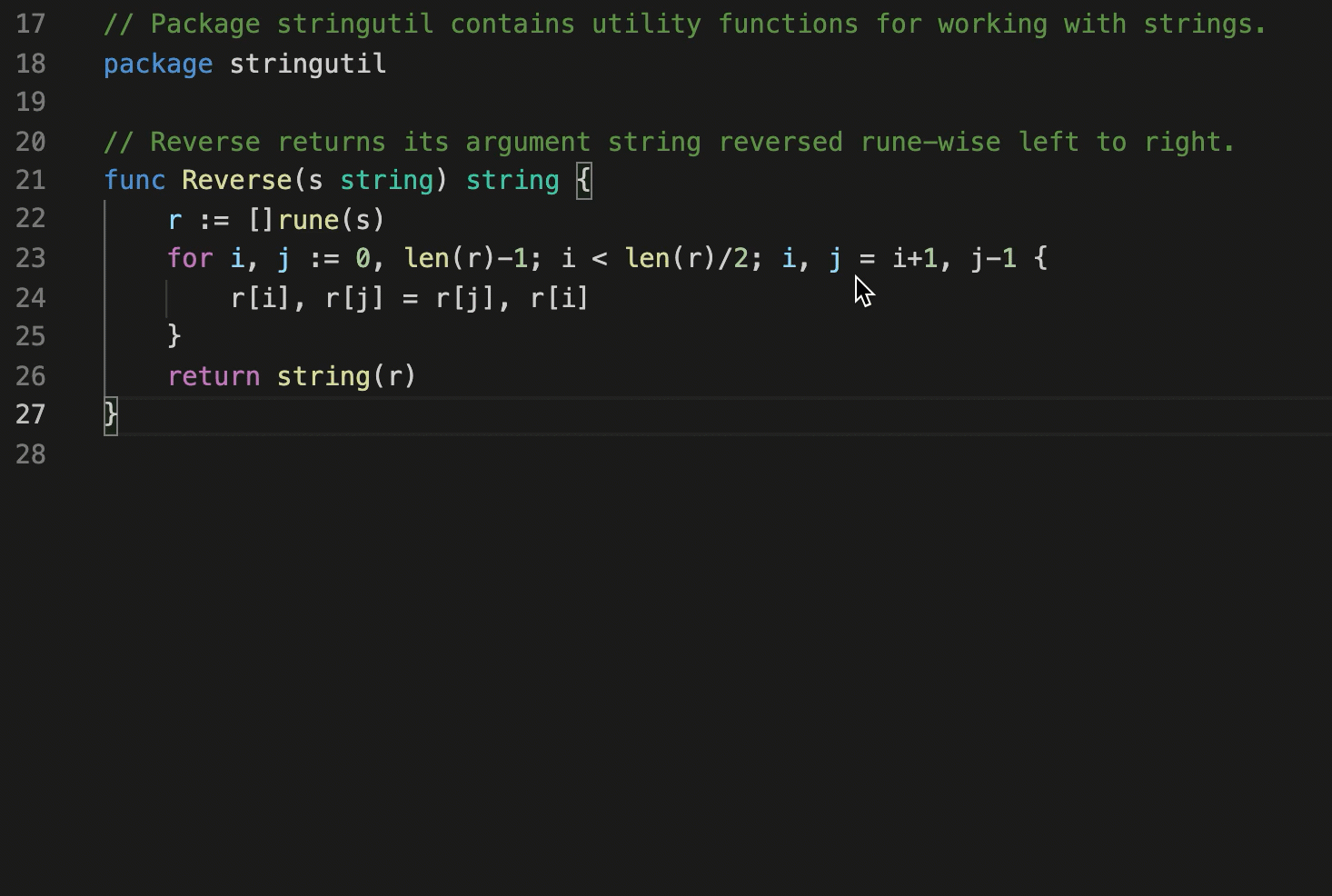
Use the Go: Add Tags to Struct Fields command to automatically generate or remove tags for your struct. This feature is provided by the gomodifytags tool invoked via gopls.
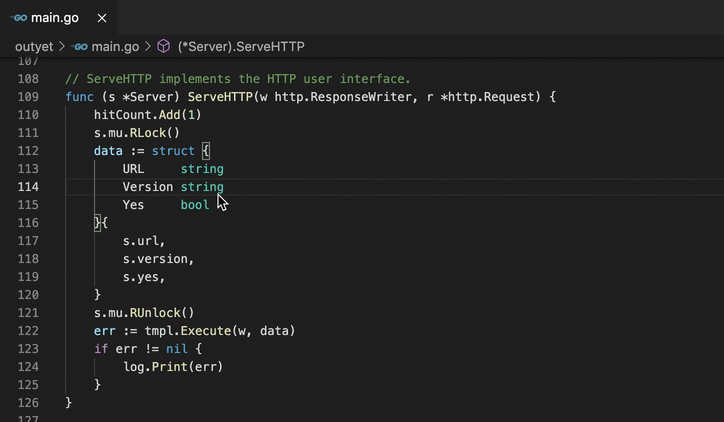
Use the Go: Generate Interface Stubs command to automatically generate method stubs for a given interface. This feature is provided by the impl tool.
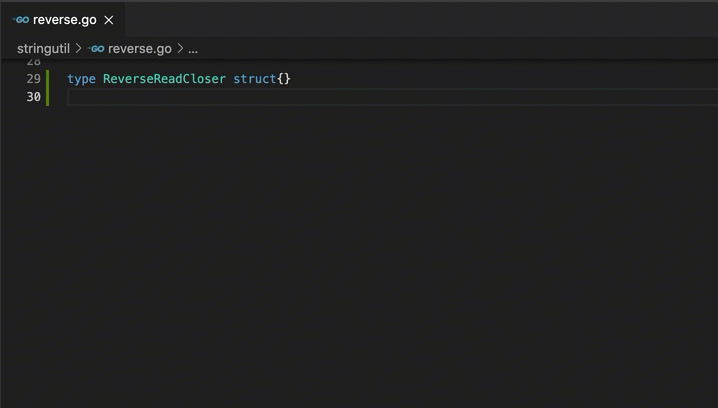
Easily generate unit tests for your project by running one of the Go: Generate Unit Tests for ... commands. This can be done at a function, file, or package level. This feature is provided by the gotests tool.
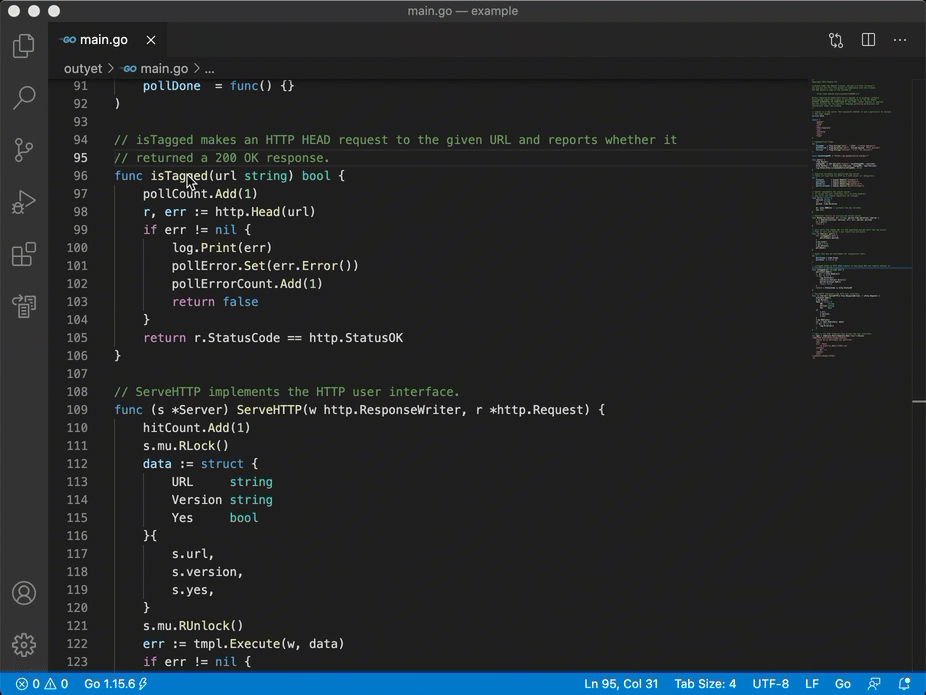
Use the Code Action to automatically fill a struct literal with its default values. The Go language server provides this capability as a refactor.rewrite type code action.
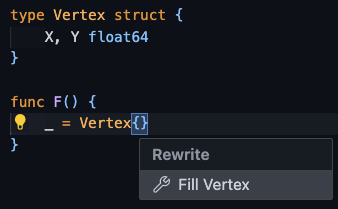
Note: The old "Go: Fill struct" command was removed in v0.40.0 in favor of the Code Action.
The extension, powered by the Go language server (gopls), offers various diagnostics and analyses features,
and often with quick fixes to address detected issues.
Compile and type errors are shown as you type by default. This works not only Go source code, but also go.mod, go.work, and Go template files.
The Go language server (gopls) reports vet errors and runs many useful analyzers as you type. A full list of analyzers that gopls uses can be found in the analyses settings section.
You can configure an extra linter to run on file save. This behavior is configurable through the "go.lintOnSave" setting.
The default lint tool is staticcheck. Popular alternative linters such as golint, golangci-lint and revive can be used instead by configuring the "go.lintTool" setting. For a complete overview of linter options, see the documentation for diagnostic tools.
The extension checks the 3rd party dependencies in your code and surfaces vulnerabilities known to the Go vulnerability database. There are two modes that complement each other.
-
Import-based analysis: this can be enabled using the
"go.diagnostic.vulncheck": "Imports"setting. You can turn on and off this analysis conveniently with the "Go: Toggle Vulncheck" command. In this mode,goplsreports vulnerabilities that affect packages directly and indirectly used by your code. The diagnostics are reported in thego.modfile along with quick fixes to help upgrading vulnerable modules. -
Govulncheckanalysis: this is based on thegolang.org/x/vuln/cmd/govulnchecktool, which is embedded ingopls. This provides a low-noise, reliable way to inspect known vulnerabilities. This only surfaces vulnerabilities that actually affect your code, based on which functions in your code are transitively calling vulnerable functions. This can be accessible by thegoplsrun_govulncheckcode lens. The import-based analysis result also provides the"Run govulncheck to verify"option as a quick fix.
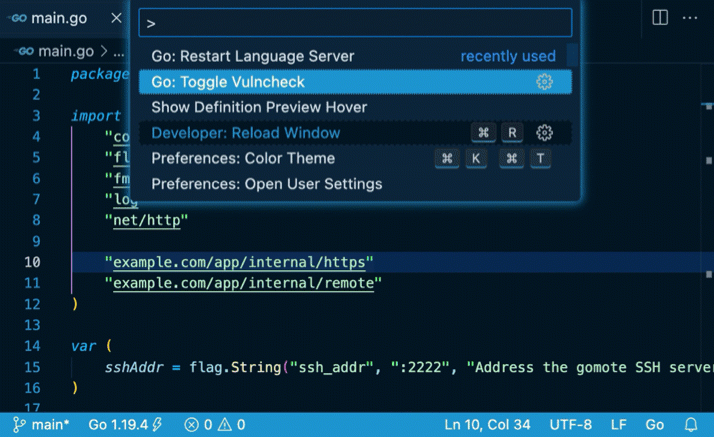 Go: Toggle Vulncheck (vulncheck.mp4)
Go: Toggle Vulncheck (vulncheck.mp4) These features require gopls v0.11.0 or newer.
Please share your feedback at https://go.dev/s/vsc-vulncheck-feedback. Report a bug and feature request in our issue tracker.
Notes and Caveats
- The import-based analysis uses the list of packages in the workspace modules, which may be different from what you see from
go.modfiles ifgo.workor modulereplace/excludeis used. - The govulncheck analysis result can become stale as you modify code or the Go vulnerability database is updated. In order to invalidate the analysis results manually, use the [
"Reset go.mod diagnostics"] codelens shown on the top of thego.modfile. Otherwise, the result will be automatically invalidated after an hour. - These features currently don't report vulnerabilities in the standard libraries or tool chains. We are still investigating UX on where to surface the findings and how to help users handle the issues.
- The extension does not scan private packages nor send any information on private modules. All the analysis is done by pulling a list of known vulnerable modules from the Go vulnerability database and then computing the intersection locally.
To run your code without debugging, use the keyboard shortcut Ctrl+F5 or run the command Debug: Start without Debugging. To debug, see Debugging below.
This command requires you to have a launch configuration in a launch.json file. To open or create your launch.json, run the Debug: Open launch.json command. Use the default Go: Launch file configuration.
Behind the scenes, the Debug: Start without Debugging command calls go run. go run usually requires the path to the file to run, so your launch.json should contain "program": "${file}".
Test UI and Code lenses allow users to easily run tests, benchmarks, and profiles for a given function, file, package, or workspace.
Alternatively, the same functionality is available through a set of commands: Go: Test Function At Cursor, Go: Test File, Go: Test Package, and Go: Test All Packages in Workspace.
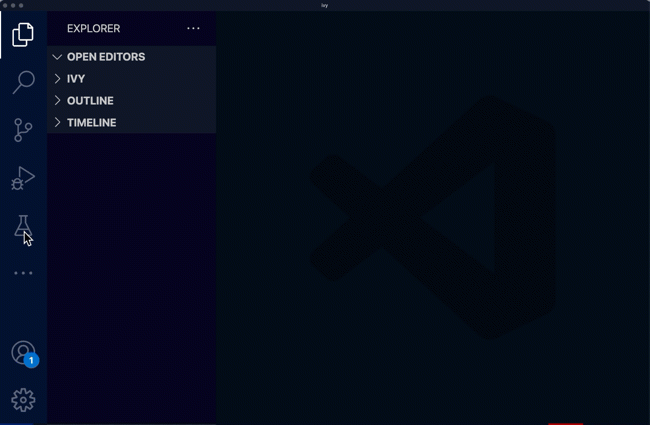
Show code coverage in the editor, either after running a test or on-demand. This can be done via the commands: Go: Apply Cover Profile and Go: Toggle Test Coverage in Current Package.
"Go Test: Profile" menu in Test UI collects CPU/Memory/Mutex profiles and allows visualizing them using pprof (go tool pprof).
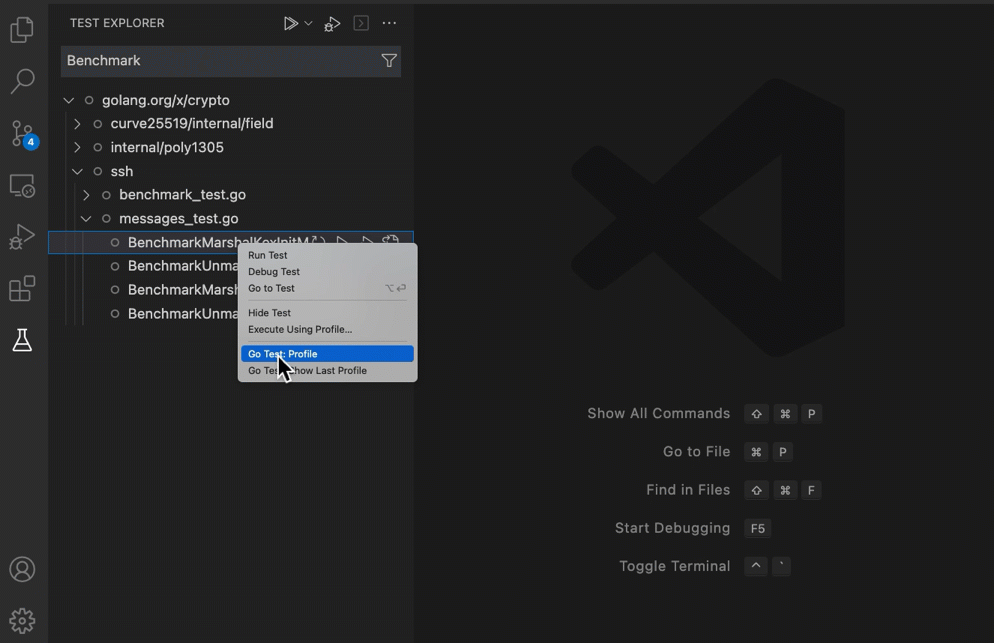
This extension offers debugging of Go programs. See the debugging documentation for more information.
Export your current file to the Go Playground via the Go: Run On Go Playground command. This is useful for quickly creating a piece of sample code.
✏️ Want to contribute to this wiki?
Update the source and send a PR.